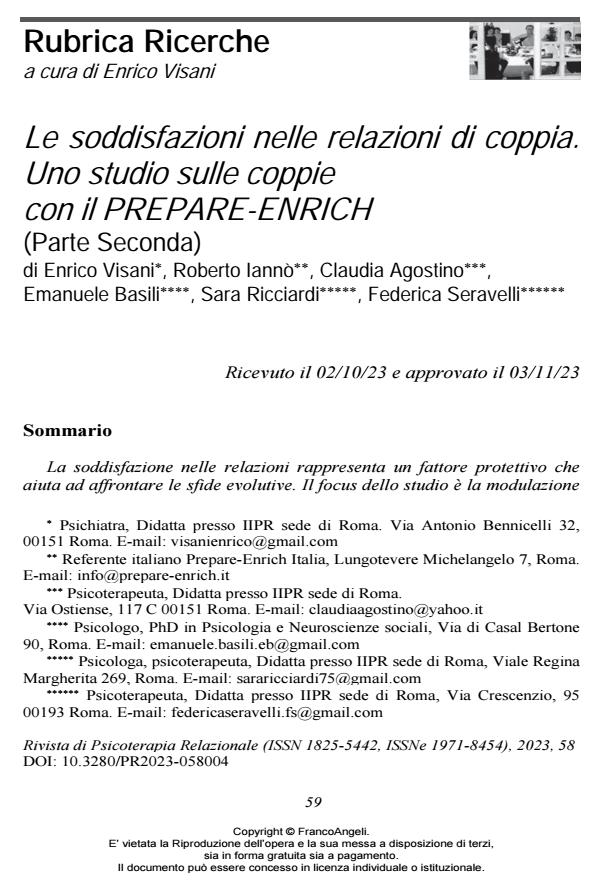Le soddisfazioni nelle relazioni di coppia. Uno studio sulle coppie con il PREPARE-ENRICH, (Parte Seconda)
Titolo Rivista RIVISTA DI PSICOTERAPIA RELAZIONALE
Autori/Curatori Enrico Visani, Roberto Iannò, Claudia Agostino, Emanuele Basili, Sara Ricciardi, Federica Seravelli
Anno di pubblicazione 2024 Fascicolo 2023/58
Lingua Italiano Numero pagine 20 P. 59-78 Dimensione file 257 KB
DOI 10.3280/PR2023-058004
Il DOI è il codice a barre della proprietà intellettuale: per saperne di più
clicca qui
Qui sotto puoi vedere in anteprima la prima pagina di questo articolo.
Se questo articolo ti interessa, lo puoi acquistare (e scaricare in formato pdf) seguendo le facili indicazioni per acquistare il download credit. Acquista Download Credits per scaricare questo Articolo in formato PDF

FrancoAngeli è membro della Publishers International Linking Association, Inc (PILA)associazione indipendente e non profit per facilitare (attraverso i servizi tecnologici implementati da CrossRef.org) l’accesso degli studiosi ai contenuti digitali nelle pubblicazioni professionali e scientifiche
La soddisfazione nelle relazioni rappresenta un fattore protettivo che aiuta ad affrontare le sfide evolutive. Il focus dello studio è la modulazione della soddisfazione nelle coppie attraverso il confronto fra un campione do-ve è presente un livello di soddisfazione mediamente positivo (valori supe-riori alla media) con uno dove questo si mostra prevalentemente basso (va-lori inferiori alla media). A tal fine abbiamo confrontato i dati ottenuti dalla somministrazione del questionario on-line Prepare-Enrich a coppie con problematiche di relazione e con un contratto relazionale definito (CP) con quelli di coppie in preparazione al matrimonio (CPM). Il campione totale è costituito da 29 coppie (14 CPM e 15 CP), per un totale di 58 soggetti. Le dimensioni di maggiore soddisfazione nelle coppie in preparazione al matrimonio sono state: la capacità di affrontare le differenze, il vissuto di non dominanza dal partner, l’impegno, la coesione, la reciprocità dei ruoli, la comunicazione, la soddisfazione sessuale e la relazione con gli amici e le famiglie.
Parole chiave:ricerca coppie, soddisfazione coppia, Prepare-Enrich, Modello Circonflesso di Olson.
Enrico Visani, Roberto Iannò, Claudia Agostino, Emanuele Basili, Sara Ricciardi, Federica Seravelli, Le soddisfazioni nelle relazioni di coppia. Uno studio sulle coppie con il PREPARE-ENRICH, (Parte Seconda) in "RIVISTA DI PSICOTERAPIA RELAZIONALE " 58/2023, pp 59-78, DOI: 10.3280/PR2023-058004